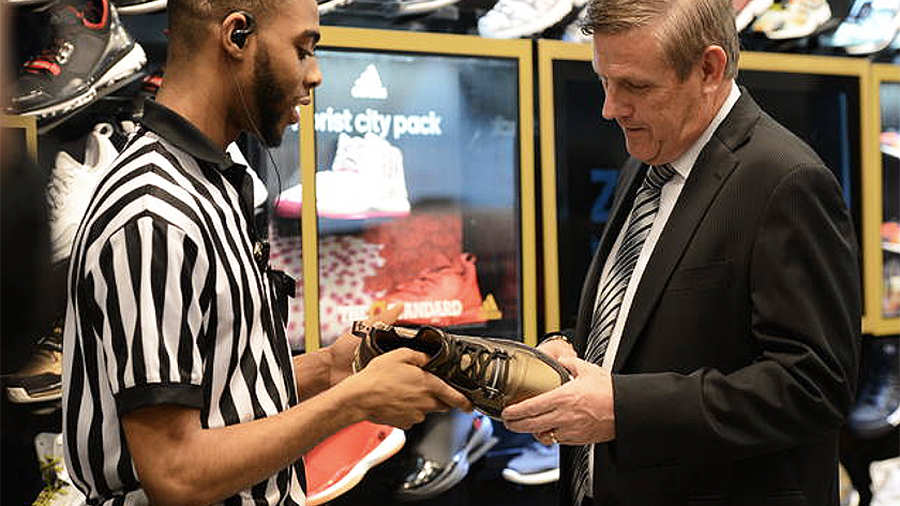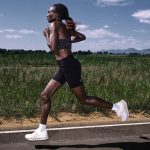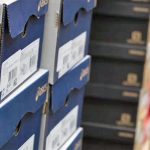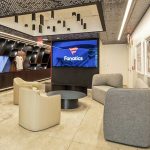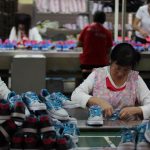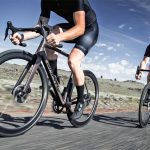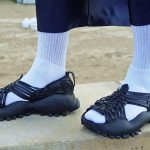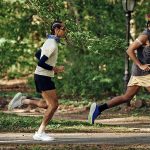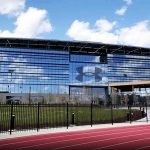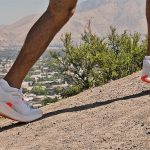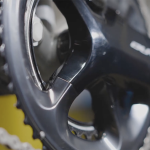Speaking at the Evercore ISI Consumer and Retail Conference, Dick Johnson, Foot Locker’s chairman and CEO, expressed confidence that the sneaker cycle received a significant boost during the pandemic. He also believes the retailer’s ongoing push to amplify assortments of non-Nike brands will better position Foot Locker to capitalize on the trend.
“The casualization of the U.S. started well before the pandemic, and the crisis augmented existing tailwinds behind sneakers,” he said. “If you go two-plus years without putting on brown or black leather shoes, your feet don’t want to go back into those shoes. I think that’s something that’s certainly going to continue,” continued Johnson. “But that had started long before the pandemic, and I think as people start to come back out from the pandemic, it just becomes much more natural and much more comfortable for them to have sneakers on their feet.”
He also said wearing sneakers has become more acceptable across occasions and noted, “I can wear my triple black sneakers with my suit to a wedding or funeral, and nobody knows the difference.”
Many consumers also use sneakers as a form of “self-expression,” particularly younger generations. He added, “I think that even folks in slightly older generations are very comfortable with sneakers on their feet, and we see it continuing.”
However, the primary discussion at the investor event was Foot Locker’s significant ongoing changes to its product mix.
In late February, the retailer announced that Nike’s portion of Foot Locker’s sales would decline to about 55 percent by the fourth quarter of 2022, down from approximately 65 percent in the 2021 fourth quarter and 75 percent overall for 2020. Foot Locker will also receive less “high heat” or marque products, such as retro Jordans.
The reduction is part of Nike’s consolidation of its wholesale distribution that has included the outright exit of some retail partners as the brand has accelerated its direct-to-consumer (DTC) push.
Foot Locker’s move to emphasize other footwear brands showed encouraging signs in the first quarter. While overall comps in the quarter were down 1.9 percent in the period due to tough year-ago comparisons against stimulus spending, comps of non-Nike products increased in the high-teens.
Foot Locker expects earnings and sales for 2022 to land at the upper end of the range set at the start of the year due to the solid first-quarter results, strong inventory position and strengthening vendor relationships.
At the start of the year, Foot Locker had guided comps down 8 percent to 10 percent due to the Nike cutbacks and tough comparisons in the first half.
At the Evercore conference, Johnson said the introduction of its FLX membership program had given Foot Locker deeper consumer insights to help guide the allocation overhaul. One message the retailer heard loudly from customers was a call for more variety. He said, “While we still sell a lot of Nike products, and we’ll continue to sell a lot of Nike products, we’ve learned that our customers want choice.”
The data shows that 40 percent of mobile purchases contain more than one brand, whether a headwear or an apparel brand or another sneaker brand. The data also indicates that the retailer’s most frequent consumers buy three footwear brands over two years.
Johnson said Foot Locker had called out a push toward greater diversification of brands at its Investor Day in March 2018, with insights showing consumers looking for more choices. However, having so much Nike product challenged presentations for other brands. He elaborated, “When you have as much open to buy tied up with one vendor as we had, it’s difficult to show brands 2, 3, 4, 5 as being meaningful and having great storytelling inside the store.”
Johnson said the higher level of customer data is also helping Foot Locker “broaden that aperture of what sneaker culture includes and entails.”
For instance, he noted that the classic six-inch Timberland boot has “always been right on the fringe” of sneaker culture. He said, “Certainly, it’s not a sneaker, right? When you think of the definition of a sneaker, it’s not a sneaker. But our core consumer uses that boot as a form of self-expression.”
Such broader thinking helped Foot Locker open up Crocs 18 months ago, and the brand is finding strong success. Said Johnson, “Now we’re doing collaborations with General Mills and Crocs and selling out just like a retro launch.”
Andrew Page, EVP and CFO, said consumers’ increasing focus on “self-expression” extends across product ranges. He said, “They use their sneakers, headwear, and fleece pieces as forms of self-expression, and you know we want to be that house of brands that support them.” Asked how Nike now fits into the retailer’s mix, Johnson said Foot Locker would continue to have access to high-heat launches but “a little less” depth and breadth as they’ve had in the past. However, the retailer continues to work closely with Nike in other areas.
Johnson said, “We are aligned with Nike around our opportunities to accelerate, grow and further develop the basketball category and the culture of basketball around not just player-edition shoes, not just Jordan retros, but the culture of basketball. We’re also aligned on continuing to evolve sneaker culture and that can go from performance running to lifestyle running and casual vulcanized shoes. We’re going to be able to continue to expand and explore what sneaker culture means.”
Foot Locker and Nike are also aligned in expanding Foot Locker’s kids’ business. Johnson said, “Our Kids Foot Locker business, and kids at all of our banners, is one of the greatest customer acquisition tools that we’ve got. When Mom and Dad have grown up with sneakers with retro launches and Air Force Ones, they want Junior and Janie to both play the part and look the role and use sneakers as their self-expression when they’re young. It has become a great customer acquisition tool for us. And we’re very aligned with Nike on what that means going forward.”
Page said all other vendors want to do more business with Foot Locker, and Nike’s move helped Foot Locker “amplify those discussions.”
Page said, “If you go back to Foot Locker’s origin, our origin has always been to delight consumers and amplify other brands. So we’re going to lean in; you’ll start to see us flex more of that muscle of amplifying other brands, delighting consumers and meeting them where they want to be.”
At the same time, the strong partnership with Nike continues. Page said, “That relationship with Nike still exists. And, again, I think both can be true because they’re running their offense, we’re running our offense and they can be net positives for both organizations.”
Johnson also believes Foot Locker has enough quality brands to compensate for Nike’s reduced allocation. Foot Locker has cited the potential to expand with Adidas, New Balance, Puma, Reebok, Timberland, Crocs, On, and Hoka One One, among others.
“We’ve done business with most of these brands over time,” said Johnson. “We haven’t necessarily treated them well in-store because so much of our store was driven by the open to buy that went to one brand. So now that we have more room and more opportunities to tell stories around their great product, there’s even more opportunity for us to get our fair share with each of those brands. We’re under-penetrated with every brand in our business except one.”
Asked about the health of malls, Johnson said mall traffic has not returned to pre-pandemic levels in most cases. On the positive side, the “intentionality of the consumer is higher when they enter the mall,” and conversion is up.
“Certainly the apocalypse around malls that was talked about in 2019 and 2020, I think we’ve all realized that the apocalypse just isn’t going to happen,” said Johnson. “Certainly, not right now. But they’ll continue to be good malls, and bad malls will likely continue to deteriorate if they don’t get some investment. But we operate across that whole cadre of mall options.”
He also highlighted the success Foot Locker’s larger off-mall locations are finding in offering more opportunities to showcase product and driving customer engagement with a local focus. Johnson said, “Certainly, it’s more square footage so we can do all the things – service women’s, service kids’, add apparel, broaden the vendor assortment, broaden the sneaker assortment. But most importantly, we can connect deeply with the community where that store sits.”
Asked about supply chain pressures, Johnson said Foot Locker sees congestion at West Coast ports clear up “a little bit.” Foot Locker ended the first quarter with inventory ahead 37 percent, benefiting from improved receipt flow.
Johnson estimated that over the holiday season, about 100 container ships anchored off the West Coast ports of Los Angeles and Long Beach, and now the number is in the high-30s and low-40s.
“It’s still unpredictable,” added Johnson.” There’s still a container imbalance, and there’s still a container ship imbalance. So it’s not flowing, and it’s not as predictable coming through the ports and then getting to our stores as we’d like. There will be a steady flow, but there may be some bumps.”
Johnson noted that last year’s factory shutdowns in Vietnam were not felt right away because footwear was sitting on boats, and the repercussions from the lockdowns in China may likewise be delayed. Said Johnson, “We’ve seen a slowdown in certain ports, but certain Chinese ports are still shipping great guns. So I think it’s mixed. But I feel good certainly about where our receipt flow is and where our inventory ended the first quarter.”
Photo courtesy Foot Locker

